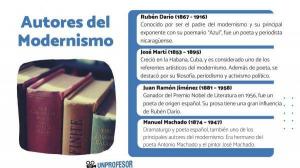4 main AUTHORS of MODERNISM

Art and culture respond to the changes experienced in different historical periods. It is the social conditions, the search for new forms of expression and understanding the world, which gives rise to different authors and artists coming together to consolidate a movement. In this lesson from a teacher we will expose the main authors of modernism, an artistic and literary trend that was created through late 19th and early 20th century in western literature.
Within the Spanish language, the modernism developed as a multidisciplinary proposal in poetry, narrative, design and the architecture, in order to recover cosmopolitanism and cultism in the fine arts. With an aesthetic full of preciousness and beautification, authors in Latin America and Spain innovated works that gave the movement its name.
Rubén Darío (1867 - 1916)
Known for being the father of modernism and its main exponent With his collection of poems "Azul", he was a Nicaraguan poet and journalist. He grew up in an environment and life circumstances that shaped him literary and academic. For example, with only 15 he was welcomed in El Salvador by the Guatemalan poet
Joaquín Méndez Bonet. In addition, he had the opportunity to meet Francisco Gavidia, Salvadoran poet. By settling in this circle, Darío managed to get in touch with the literary currents of his time, especially French symbolism.He was a precocious traveler. After returning to Nicaragua and collaborating in different newspapers, he moved to Chile where he became friends and collaborated with the writer Pedro Balmaceda Toro. This accumulation of experiences provided the basis for his prose. From this moment, Ruben Dario He does not stop writing or traveling, he even works as a diplomat. His life ends in Barcelona where he publishes his last poetic work. It is worth highlighting the main titles of this author of modernism:
- Blue (1888)
- Profane prose and other poems (1896)
- Songs of life and hope (1905)
- The Wandering Song (1907)
José Martí (1853 - 1895)
Jose Marti He grew up in Havana, Cuba, and is considered one of the artistic references of modernism. Besides being a poet, he stood out for his philosophy, journalism and political activism, where he had a crucial role in the creation of the Cuban Revolutionary Party. This led him to be a promoter of the independence of his country.
The revolutionary vein of the author could also be identified in his lyrics, which is why he published gazettes and magazines such as The Devil Cojuelo or The Free Homeland. Like Rubén Darío, I had a traveling spirit that he began with his exile to Spain for belonging to pro-independence groups. He toured parts of Europe and America. His poetry is not only a reflection of a cultural movement, it is also the basis of his figure as one of the main promoters of civil liberty in Latin America. With this, we will list the most important works of him:
- The Spanish Republic before the Cuban Revolution (1973)
- Ismaelillo (1882)
- Simple Verses (1891)
- Montecristi Manifesto (1895)
Juan Ramón Jiménez (1881 - 1958)
Winner of Nobel Prize in Literature in 1956, he was a poet of Spanish origin. His prose has a great influence from Rubén Darío, it was even his passion for literature that led him to leave the university, where he was studying law.
With an unstable temperament, neurotic and depressive, he was admitted to hospitals on different occasions. Nevertheless, his travels and his literature continued. With the disasters of the Spanish Civil War in 1936 he decided to go into exile in the United States. Then he lives in Cuba and finally his life ends in Puerto Rico.
His work is usually divided into three stages: a first of character sensitive between 1898 and 1915, loaded with the influences of French symbolism and the modernism of Rubén Darío; a second cut intellectual between 1916 and 1936, where he delves into reflections on loneliness and transcendent elements of life; and, finally, a stage called "True" between 1937 and 1958, where he captures the feeling and thinking of him during exile. Within these three moments the works stand out:
- Nymphaeas (1900)
- Silversmith and I (1914)
- Diary of a newly married poet (1916)
- A meridian hill (1950)
Manuel Machado (1874 - 1947)
He was a Spanish playwright and poet, also one of the leading authors of modernism. Son of a family loaded with art, he was the poet's brother Antonio Machado and the painter José Machado.
He started writing in the magazine The caricature and it was thanks to meeting Rubén Darío that he entered modernism. Although throughout his life he wrote collaborations with his brother Antonio de el, always he considered Rubén Darío as his teacher. This influence led him to write the works that positioned him as one of the main authors of the literary movement:
- Soul (1902)
- Caprichos (1905)
- The national holiday (1906)
Although we have made a tour of the authors of modernism, it is pertinent to clarify what this movement consisted of and what were its main features.
First, was developed between 1880 and 1920 and it was exclusively the result of Spanish-speaking art. With the motto of "art for art's sake," he sought to refine the aesthetics and literary forms that had lost with the industrialization processes and the development of capitalism of the century elapsed.
Second, as can be identified in the lives of the authors of it, it was cosmopolitan in character. He was anchored to humanism and the fine arts, where there was a rejection and criticism of the literature of the Victorian era.
Among the main characteristics of it is the use of a cultured language, free verse and a rejection of everyday reality. It was these bases that gave way to the contemporary era and the different literary currents that emerged later.

